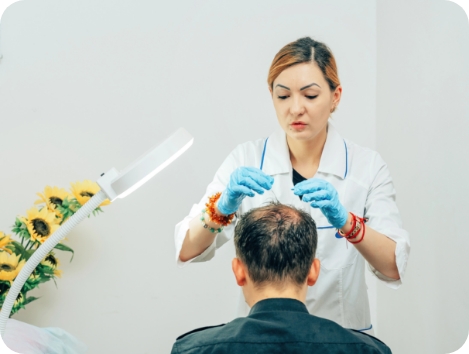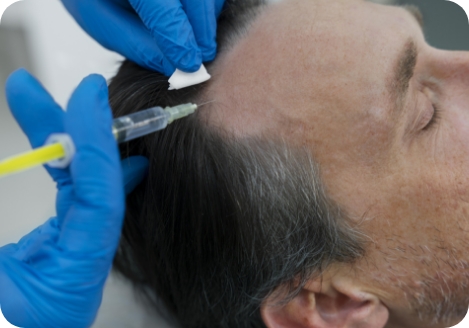Exosomes And Growth Factors
The cutting edge in Hair Restoration Science
Overview
At the Hair Restoration Institute of Minnesota, we offer the latest in advanced, non-surgical therapies to support natural hair growth and scalp rejuvenation— Exosome and Growth Factor Therapy. These cutting-edge treatments harness the regenerative power of cellular-derived proteins, extracellular vesicles, and tissue matrices to stimulate hair follicles, improve scalp health, and restore thinning hair.
These therapies are available as stand-alone procedures or as enhancements to Platelet-Rich Plasma (PRP) therapy for even more powerful results.
What Are Growth Factors?
Growth factors are specialized signaling proteins naturally produced by the body. They play a central role in regulating cell growth, repair, and regeneration. Think of them as messengers that tell cells what to do—whether that’s to divide, heal, build new tissue, or reduce inflammation.
These proteins bind to receptors on the surface of target cells, triggering cascades of intracellular signals that activate genes and cellular processes necessary for tissue regeneration and structural repair.
In the context of skin and hair, growth factors are especially active in:
- Epithelial regeneration (healing the scalp)
- Angiogenesis (forming new capillaries to nourish hair follicles)
- Stem cell activation (promoting new cell production in hair follicle niches)
- Anti-inflammatory signaling (calming overactive immune responses that may damage follicles)
What Are Exosomes?
Exosomes are microscopic extracellular vesicles naturally secreted by cells, rich in signaling molecules like growth factors, proteins, and cytokines. They play a key role in cell-to-cell communication and help regulate inflammation, regeneration, and tissue repair.
Inside each exosome are proteins, lipids, messenger RNA (mRNA), microRNA (miRNA), and growth factors—the key building blocks and instructions that cells use to coordinate repair, regeneration, and immune modulation.

When exosomes are delivered to the scalp via microinjections, they work as messengers of regeneration:
- Cellular Communication: Exosomes transfer mRNA and proteins that “reprogram” nearby scalp cells, helping to restore a regenerative environment.
- Anti-Inflammatory Action: They downregulate inflammatory cytokines and immune activity that may otherwise contribute to follicle miniaturization.
- Angiogenesis (New Blood Vessel Formation): They encourage the formation of new capillaries, improving oxygen and nutrient delivery to follicles.
- Stimulation of Follicular Stem Cells: Exosomes activate dermal papilla cells and bulge-area stem cells—the biological command centers that drive hair growth.
- Support of the Extracellular Matrix (ECM): They enhance the structural foundation of the scalp, strengthening th
How These Treatments Work

When injected into targeted areas of the scalp, exosomes and growth factors:
- Deliver key proteins and signaling molecules directly to dormant or weakened follicles
- Enhance the local microenvironment to promote healing and regeneration
- Reduce inflammation that may contribute to follicle miniaturization
- Improve hair density, reduce shedding, and promote thicker strands over time
- Support angiogenesis (new blood vessel formation) to nourish follicles
Unlike PRP, which relies on your body’s platelets, these therapies provide an allogeneic source of bioactive factors—meaning they come from donated tissue and are prepared according to rigorous FDA-registered tissue bank standards. The treatments used at HRI are exclusively from the umbilical cords of happy, healthy babies delivered via cesarean section. Umbilical cord tissue is a rich, young biological source of growth factors and extracellular vesicles like exosomes, far more potent than those found in adult tissues. Because it comes from a developmental stage optimized for healing, it contains higher concentrations of regenerative proteins, anti-inflammatory signals, and structural components. This makes it uniquely suited to support scalp rejuvenation, hair follicle repair, and cellular communication in hair restoration therapies.
By using these ethically sourced, medically screened tissues—processed under FDA-registered and AATB-accredited guidelines—we ensure both biologic integrity and regulatory compliance, while delivering the most advanced regenerative solutions available today.
Who Is A Candidate For Growth Factor And Exosome Therapy?
Exosome and growth factor treatments are ideal for:
- Men and women in the early to moderate stages of hair thinning
- Patients who have not responded well to PRP or topical treatments
- Individuals seeking non-surgical alternatives to hair transplantation
- People with diffuse hair loss, friction-related alopecia, or inflammation driven thinning
- Patients with autoimmune-sensitive scalps who may not be suitable for other regenerative options
They can also be used to enhance the results of PRP, hair transplant surgery, or microneedling procedures.

Exosome Vs. Growth Factor Therapy – What’s The Difference?
| Growth Factor Matrix Support | Exosome-Based Therapy | |
|---|---|---|
| Best for those with | Moderate hair loss and thinning. Norwood 3–5. Those otherwise considering PRP. | High hair loss and balding. Norwood 6–7. Those otherwise considering Hair Transplant. |
| Mechanism | Protein-rich environment supporting structural healing | Cell-to-cell communication via extracellular vesicles |
| Works by helping | Scalp support, improved healing, structural rejuvenation | Inflammation, reactivation of dormant follicles |
| Treatment Frequency | 1–4 sessions, may be used with PRP or laser | 1–3 sessions, spaced 4–6 weeks apart |
| Results Timeline | Gradual thickening and stabilization over 3–6 months | Early improvements in 6–8 weeks, best at 3–6 months |
| Can Be Combined with PRP? | Yes | Yes |
| No blood draw required | Yes | Yes |
Schedule Your Consultation
Curious whether exosome or growth factor therapy is right for you? Schedule a private hair restoration consultation today with our team at the Hair Restoration Institute of Minnesota. We’ll review your hair loss history, medical background, and goals to help you select the most effective regenerative treatment plan.
How Are These Treatments Regulated?

The products we use are regulated by the FDA under 21 CFR Part 1271 and Section 361 of the Public Health Service Act, as human cellular and tissue based products (HCT/Ps). These therapies:
- Are minimally manipulated and intended for homologous use, meaning they serve the same basic function in the recipient as in the donor (e.g., supporting tissue repair)
- Do not contain live stem cells and are not dependent on cellular metabolism for their effect
- Are processed in facilities that follow Good Tissue Practices (GTP), Current Good Manufacturing Practices (cGMP), and are AATB accredited
We make no claims of treating disease, curing baldness, or offering guaranteed regrowth. These therapies are innovative, elective procedures and are not FDA approved drugs, devices, or biologics.

Safety, Risks, And Expectations
As with any biologic injection, mild side effects may include:
- Temporary redness, swelling, or discomfort at injection sites
- Itching or sensitivity of the scalp
- Rarely, inflammation or allergic reaction
Results vary from person to person. While many patients report noticeable thickening and reduced shedding, no therapy guarantees regrowth, and multiple sessions may be needed to maintain results.
Serving Minnesota And Beyond
Located in Bloomington, MN, we serve patients from Minneapolis, St. Paul, Rochester, and the greater Midwest who are seeking leading-edge solutions for non-surgical hair loss treatment.





